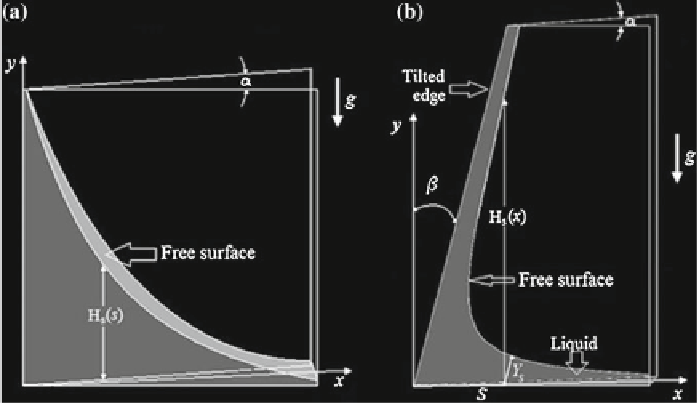Environmental Engineering Reference
In-Depth Information
Fig. 1
a
Scheme of the Taylor-Hauksbee cell. In this case the equilibrium profiles are given by
H
s
(
)
.
b
Taylor-Hauksbee cell with a tilted edge. In this case Y
s
is a distance to the equilibrium
profile along the line parallel to the tilted edge and that starts at x
x
=
=
sandy
0; Thus the most
suitable coordinate system is given by
(
s
,
Y
s
)
In order to compare the latter theoretical profile with experiments, we performed
a series of experiments with silicon oil of viscosity
μ
=
100 cP, surface tension
m
3
and an aperture angle of
˃
=
ʱ
=
0.0166 rad.
In experiments we used a digital Cannon Réflex T3i camera to take pictures and a
video recording of the capillary rise. In Fig.
2
we show a picture with the equilibrium
profile and also a comparison between the experimental data and the theoretical
profile given by Eq. (
3
). The fit is very good assuming that
0
.
0215N/m, density
ˁ
=
971 kg
/
ʸ
=
0 rad.
2.2 Cell with Tilted Edge
In this part we consider the cases of cells with tilted edges with respect to the ver-
tical, see Fig.
1
b. The usual Cartesian coordinates appears no suitable to depict the
equilibrium profiles because it is possible that for some values of
x
there are two
values of
H
(
x
) (the equilibrium profile). Thus, the concept of function can be lost.
Instead, we choose the rotated coordinate system
x
,
y
)
(
to describe the equilib-
rium profile. We analyze the problem for the point
(
s
,
Y
s
)
shown in Fig.
1
b.
s
is the
x
y
distance from the lower apex
to any point along
x
, whereas
Y
s
is
the distance to the equilibrium profile along the line parallel to the tilted edge
(
=
0
,
=
0
)
y
)
(
and that starts at the point
x
=
and
y
=
s
cos
ʲ
s
sin
ʲ
; thus the equilibrium profile
is given by the injective function
y
(
x
)
.

Search WWH ::

Custom Search